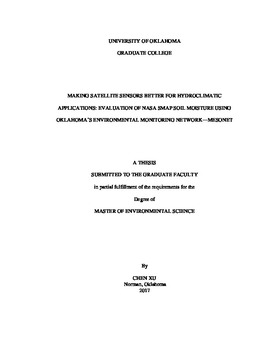| dc.description.abstract | Soil moisture, quantified as the ratio of liquid water to soil in volume or weight, is the measurement of the water that is held in the space between soil particles. Understanding the components of soil, particularly its water concentration, is an important aspect of the hydrological cycle. This concept is key in understanding the relationship of the circulation pathway of water and heat as they travel between Earth’s surface and then the atmosphere. This interaction has a great impact on weather, ecosystems and their climates. Advances in remote sensing, particularly microwave remote sensing, have provided significant information on soil water content. If coupled with geographic pieces of information such as soil types and topographical details, it may be able to provide accurate data on soil water content on a global basis. National Aeronautics and Space Administration (NASA)’s Soil Moisture Active Passive (SMAP) mission takes place in an orbiting observatory that measures the amount of water in the top 10 cm of soil on Earth’s surface every 2 – 3 days since 2015. Environmental factors including precipitation, temperature, vegetation cover, soil properties (density and texture), and surface roughness may all affect the accuracy of the remotely sensed soil moisture measurement. There being so many variables that can affect data, it is critical to compare SMAP soil moisture data with in situ observations for sensor calibration and hydrometeorological applications.
The objective of this study is to evaluate the potential utility of the surface soil moisture data retrieved from remote sensing techniques, those derived from SMAP satellites in particular, by comparing them with the ground-observed data of the Oklahoma Mesonet that monitors a number of atmospheric and hydrologic variables, including solar radiation, humidity, temperature, wind speed and direction, and soil moisture. This data will aid in operational weather forecasting and environmental research across the state. First, the spatiotemporal variation pattern of statewide soil moisture is described with site-wise monthly average Mesonet data from the top 5, 25, and 60 cm of soil respectively. This would then show the correlation between the remotely-sensed SMAP soil moisture data and Mesonet soil moisture observations at three soil depths, both spatially – statewide, as well as regions of three precipitation zones, three temperature zones, and nine climatic zones, and temporally – for each season. Three specific hypotheses and findings will be made and reached. First, the remotely sensed SMAP retrievals relatively fit and correlate well with Mesonet data. Spatially, the wetter and warmer climatic regions have a higher correlation and lower error in the SMAP soil moisture. During the summer and winter for short periods, the SMAP soil moisture data has a greater degree of deviations to the observations than in the other times of the year. Second, the Mesonet data of the top 5 cm of soil shows the best correlation with the SMAP information. This reconfirms the remotely sensed SMAP data validity for measuring top soil layer than root zone soil moisture. Third and lastly, the SMAP soil moisture closely corresponds with environmental conditions. This is especially pertinent with precipitation events and temperature variations. This study proves the hypotheses and concludes that the remotely sensed soil moisture data retrieved from SMAP is considered to be effective in observing land surface soil moisture data in Oklahoma. Furthermore, the quantitative findings support electrical engineers to calibrate the errors in remote sensing signals and retrieval algorithms, and thus to develop more functional satellite sensors for future missions. | en_US |
